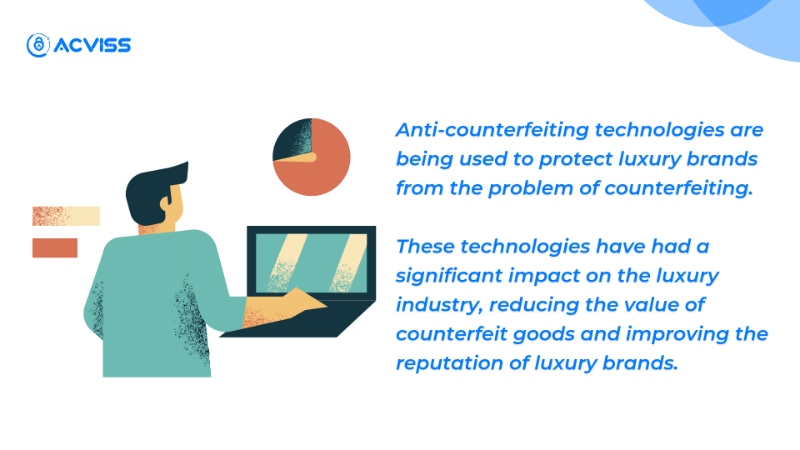How Anti-Counterfeiting Technology is Being Used to Protect Luxury Brands

Luxury goods are a symbol of status, wealth, and exclusivity. From designer handbags to high-end watches, these items are not only beautiful but also a statement of personal taste and style. Unfortunately, the popularity of luxury goods has also made them a target for counterfeiters who produce fake products that look like the real thing.
The global value of counterfeit goods in 2022 was estimated to be around $3 trillion, with luxury goods accounting for a significant portion of it. In fact, luxury goods are some of the most counterfeited products, with handbags, watches, and jewellery as the most commonly counterfeited items.
Counterfeiting in the luxury industry has become a serious problem, costing brands millions of dollars in lost revenue and damaging their reputation. However, with the advancements in technology, anti-counterfeiting technologies are being used to protect luxury brands.
Anti-Counterfeiting Technologies that are Used to Combat Counterfeiting
Luxury brands are turning to advanced anti-counterfeiting technologies. Some of the most commonly used anti-counterfeiting technologies include:
1. Hologram Stickers
Hologram stickers are one of the most applied anti-counterfeiting technology. They are a cost-effective way to protect luxury products from counterfeiting. Hologram stickers are tamper-evident and have unique designs that cannot be replicated easily, making them difficult to counterfeit. Luxury brands use hologram stickers on their products to prove their authenticity and protect against counterfeits. While holograms can be difficult to replicate, they are not foolproof. Sophisticated counterfeiters can replicate holograms with high accuracy, making it difficult for end-users to differentiate between genuine and counterfeit products.
2. RFID Technology
RFID technology is another popular anti-counterfeiting technology used by luxury brands. RFID technology uses radio waves to communicate information between an RFID tag and an RFID reader. Luxury brands use RFID tags to track their products and ensure they are not counterfeited. RFID tags are difficult to replicate, making them an effective anti-counterfeiting technology. However, RFID tags and readers can be expensive compared to other anti-counterfeiting solutions. This can make it difficult for smaller businesses or manufacturers to implement RFID technology.
3. Microprinting
Microprinting is a security feature that involves printing small text or images that are difficult to see without magnification. Luxury brands use microprinting to protect their products from counterfeiting. Microprinting is an expensive technology to implement. The cost of the equipment, materials, and expertise required to set up a microprinting system can be significant, which can make it impractical for some companies. Microprinting can be used on product packaging, labels, and security features such as holograms and barcodes.
4. Watermarks
Watermarks are another popular anti-counterfeiting technology used by luxury brands. Watermarks are images or patterns that are incorporated into the paper or packaging material of luxury products. Watermarks are difficult to replicate and can be used to authenticate luxury products. Luxury brands use watermarks to protect their products from counterfeiting and ensure their authenticity.
5. Security labels
Security labels are unique labels that are applied to products and cannot be easily removed or duplicated. They often include a combination of tamper-evident features, such as holograms, watermarks, and microprinting. ACVISS offers unique 2D, 3D and proprietary codes that integrate with every product unit and packaging that can be tracked and traced across the supply chain in real-time.
How Brands are Using Anti-counterfeit Solutions
Many luxury brands have already implemented anti-counterfeiting technologies to protect their products.
1. Louis Vuitton
Louis Vuitton uses a combination of anti-counterfeiting technologies to protect its products. Their products are embedded with RFID tags, which are scanned to verify their authenticity. The company also uses hologram stickers on its products to prevent counterfeiting. The hologram stickers contain a unique serial number, which is linked to a database that verifies the authenticity of the product.
2. Gucci
Gucci uses microprinting to protect its products from counterfeiting. The company uses microprinting on the labels of its products to ensure their authenticity. Microprinting is so small that it is almost impossible to replicate without sophisticated printing technology. Gucci also uses RFID tags on its products to track their movement and ensure they are not counterfeit.
3. Chanel
Chanel uses a combination of anti-counterfeiting technologies to protect its products. The company uses hologram stickers to ensure their authenticity. The unique serial number that is embedded in the hologram labels verifies the authenticity of the product. Chanel also uses watermarks on its product packaging to prevent counterfeiting.
Impact of Anti-Counterfeiting Technologies
The use of anti-counterfeiting technologies has had a significant impact on the luxury industry. It is expected to reduce the counterfeit market value significantly. In fact, the report states that the implementation of anti-counterfeiting technologies has already reduced the value of counterfeit goods by $91 billion globally.
Anti-counterfeiting technologies have also had a positive impact on the reputation of luxury brands. Consumers are becoming more aware of the problem of counterfeiting and are looking for ways to ensure that the products they purchase are authentic. By implementing anti-counterfeiting technologies, luxury brands can provide consumers with the assurance they need to make a purchase.

In short, anti-counterfeiting technologies are being used to protect luxury brands from the problem of counterfeiting. These technologies have had a significant impact on the luxury industry, reducing the value of counterfeit goods and improving the reputation of luxury brands. As the problem of counterfeiting continues to grow, the use of anti-counterfeiting technologies is expected to become even more widespread. By implementing these technologies, luxury brands can ensure the authenticity of their products and protect against counterfeiting.
Interested to learn more about anti-counterfeiting solutions to secure your brand? Get in touch with us today and protect your products and customers across online and offline channels.
